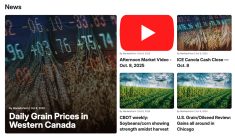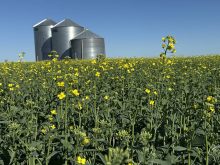In wheat, it’s obvious.
In pigs, it’s stealthy.
But the Canadian dollar’s rise has been hurting prairie farm income since harvest. Some are beginning to question whether hedging the currency factor will have to become a fact of life for producers.
“In the past, it always made sense to link the two (market price and currency exchange risk). There wasn’t as much volatility,” said Tyler Fulton, a risk management specialist with Manitoba Pork Marketing Co-op.
“It seemed the dollar had only one trend to follow, and that was lower.”
Read Also

Huge Black Sea flax crop to provide stiff competition
Russia and Kazakhstan harvested huge flax crops and will be providing stiff competition in China and the EU.
For as long as young farmers and many older farmers can remember, the Canadian dollar has steadily declined in value compared to the American dollar.
That benefited farm commodity prices, earning farmers marginally more per bushel or pound than they would have had the dollar remained locked to the American dollar.
If a farmer made a forward sale of special crops or piglets in U.S. dollars, by the time the farmer was actually paid, the declining Canadian dollar would probably have handed him a small bonus.
Some agricultural marketers such as the grain companies and the Canadian Wheat Board have locked in currency exchange rates to avoid bad surprises, but individual farmers have had little incentive to lock in the exchange rate.
But with the loonie rocketing ever upward these days, and volatility appearing as a continuing trend, risk managers like Fulton are wondering if more currency hedging options are needed.
Hog producers who market through the Manitoba co-op are able to lock in forward sales prices, but the price they are generally offered is a combination of a forward pig price and a forward currency exchange rate.
There is also a contract that allows a producer to lock in a future market price for pigs without locking in the exchange rate. But there isn’t a contract that locks in the exchange and lets the pig price float.
“It’s probably something that should be available,” said Fulton, who is considering whether to recommend that his organization start offering currency hedging independent of the market price.
The problem, Fulton said, is that farmers who want to lock in the currency rate also must lock in the pig price. Current pig prices on the futures market seem low in relation to demand, so many don’t want to lock in.
But with some analysts predicting an 85 cent US or higher Canadian dollar, they don’t want to leave that risk open.
It’s a conundrum forcing farmers to gamble on the exchange rate or lock on to an unattractive price.
“If the hog price is undervalued in the futures, but there’s real risk in the Canadian dollar, it would make a lot of sense to be able to lock in the Canadian dollar and allow the pig price to float,” said Fulton.
“We don’t currently offer that. It’s all or nothing.”
He said producers aren’t too upset about the currency situation right now because pig prices have been getting stronger at the same time that the Canadian dollar has been strengthening, but when the pig price falls, more will start to worry about their currency exposure.

















